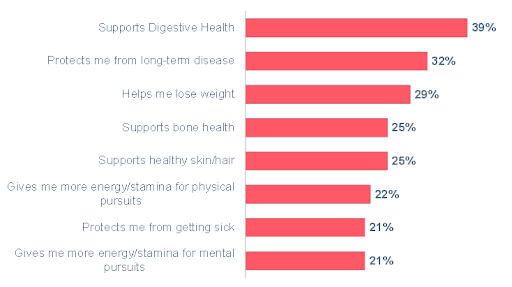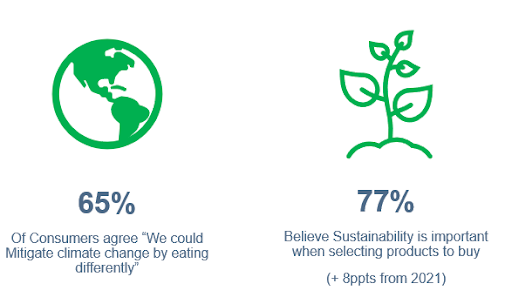Plant-Based Diets: A Growing Appetite for Health and Sustainability
by Louisa White, Senior Manager, Consumer Insights and Analytics
Increasingly, a large segment of consumers is drawn to plant-based products to achieve the positive health outcomes and environmental impacts associated with plant-based food and drinks.
When it comes to plant-based eating, the focus is shifting to moderation and limitation, not elimination. Only a tiny percentage of consumers identify as vegan, just 1.1% globally. 1 However, many consumers are limiting the amount of meat they consume due to both health and affordability concerns — globally, 24% claim to be reducing meat consumption. 2
What’s Driving the Move to a Flexitarian Diet?
The shift to adding more plant-derived foods is primarily health-driven; almost two-thirds (66%) of global consumers cite health as a reason for consuming plant-based alternatives to meat or dairy products.3 COVID-19 created a heightened awareness of consumers' health and an associated desire for food and beverages perceived as healthier, such as plant-based meat and dairy, to support their wellness and immunity.4 In particular, the pandemic accelerated consumer interest in meat substitutes, enabling companies to formulate innovative products that were heavily marketed, resulting in an increase in sales.

Source: Datassential, November 2022
Consumers are also increasingly worried about the fate of our planet. Growing awareness of the health benefits of plant-based diets has also drawn attention to the sustainability benefits of such an approach to eating, with consumers increasingly aware of the impact of meat and dairy production on greenhouse gases and global warming. Now, one-third who opt for plant-based alternatives to traditional meat and dairy products do so for sustainability reasons.5

Source (Left): Datassential, November 2022
Source (right): IRI OmniConsumer™ Survey Solutions, June 2022, n=764
Plant-Based Market Segments
The plant-based market consists of two key segments: meat substitutes and dairy alternatives. Each segment offers unique opportunities for manufacturers and appeals to different consumer preferences.
Meat Substitutes: This segment focuses on reduction, catering to individuals seeking alternatives to traditional meat products. Meat substitutes are typically made from plant-based ingredients such as soy, wheat, peas, or mushrooms, which mimic the taste and texture of meat. They offer a versatile option for consumers looking to reduce their meat consumption and are a convenient and familiar choice for individuals transitioning to a more plant-based diet or adopting a flexitarian lifestyle.
Dairy Alternatives: This category focuses on addition, targeting consumers looking for more plant-based alternatives to milk, yogurt, ice cream, etc. These products are typically made from soy, almonds, oats, coconut, or rice. Dairy alternatives have gained significant popularity, expanding beyond niche markets to become mainstream options.
By focusing on these two market segments, manufacturers can tap into the growing demand for plant-based alternatives and provide consumers with various options to suit their dietary preferences and needs. Both meat substitutes and dairy alternatives offer opportunities for innovation, product development, and meeting the evolving demands of health- and environmentally conscious consumers.
Consumer Challenges Abound in the Plant-Based Space
However, plant-based products need to evolve further to keep up the growth momentum, as most products in the market face challenges in meeting key consumer expectations and encouraging repeat purchase. To summarize, consumers are looking for:
- Taste and texture that replicate traditional meat and dairy products
- Pricing that represents good value for their money
- Products that aren’t excessively processed or contain too many artificial ingredients
- More region-specific flavor profiles to suit personal tastes
Growth in the Plant-Based Market and Looking into the Future
Despite challenging periods, plant-based consumer goods have witnessed a significant rise in demand. Both dairy alternatives and meat substitutes have increased in value, with CAGR from 2018–2022 of 5.1% and 11.7%, respectively. Long-term, plant-based categories are expected to grow at an even faster rate. GlobalData forecasts dairy alternatives will see a CAGR of 7.3% from 2022–2027, and meat substitutes will achieve 12.2% during that same period.1 By 2030, the combined plant-based foods and drinks markets are projected to grow to $160 Billion in 2030.6
Tate & Lyle Can Help You Grow Your Plant-Based Food & Beverage Business
While plant-based remains a strong opportunity, some products have failed to deliver on consumer expectations of appealing taste and texture paired with clean ingredients, impacting repeat purchases and broader acceptance.
Our plant-based ingredient portfolio can help you meet the health and sustainability needs and eating experience expectations of consumers. Together, we can overcome the inherent challenges of plant-based formulations.
To learn more about our plant-based ingredients and how we can help you meet consumer demand for alternative food and beverage products, contact us today.
Sources:
1. World Animal Foundation
2. New-Nutrition Business 2022 survey
3. GlobalData 2022 Q1 global consumer survey
4. Global Data, Thematic Intelligence: Plant-Based Diets, March 2023
5. Innova food & drink trends 2023 (Trends survey 2022)
6. Mintel Report (November 2022) – Future of plant-based food & drink

